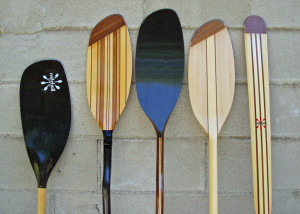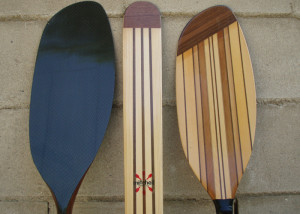
Editor note: This is a general how-to introduction to the basics of kayak paddles. If you want more detailed information see our story Expert Advice On Selecting The Right Kayak Paddle For You And Your Boat
There are many great kayaks and some not so great ones on the market, so picking the right kayak takes some thought. Ditto with kayak paddle. Yes, any paddle will move a kayak through the water . . . But a kayak paddle is even more an extension of your body than the kayak you are paddling; some will fit you, your kayak and your personal paddling style better than others. The better your paddle fits you, the more you are going to enjoy paddling. Owning the right paddle will enhance your kayaking enjoyment for years to come.
With a kayak paddle you have to choose style, length, and materials. The materials will largely determine weight of the paddle, its durability, its “feel,” and, of course, it’s price.
Style: Not so long ago, kayakers built their own paddles by attaching pieces of plywood to a wooden closet pole. Before that, they fashioned paddles from whatever wood was handy.
But the sport of kayaking has exploded in popularity in recent years and you now have many, many paddle options from basic to ultra-specialized. The most basic paddles have a shaft, usually of aluminum or plastic, and flat plastic blades. They’ll move a kayak. And they are usually very cheap. A few are even light and well-made enough to feel pretty good when you are paddling with them.

Beyond entry-level, the paddle blades tend to curve to “cup” the water for more efficiency and the paddles generally get lighter. Paddles for whitewater kayaking (on swiftly moving rivers) have big, curved blades, often reinforced for durability. Recreational/ touring paddles come with a variety of blade shapes and curvatures, all designed to move the kayak farther with less effort. Some racing blades are so cupped they look like oversized soupspoons. The traditional “Greenland” paddle has very long, narrow, flat blades (the Inuits who invented kayaks had only driftwood to work with . . .) which are easier on the arms and shoulders for long-distance paddling.

Length: Ideal length varies not only by the type of paddling, but also by the width of the boat, and your paddling style. Whitewater paddles usually mount those big, rugged blades on comparatively short shafts for maximum leverage (when you need to turn a whitewater kayak, you need to turn it NOW!). Recreational/Touring paddles can be longer or shorter depending on whether you paddle with a “high angle” or a “low angle.” High angle paddling is more aggressive, accelerates, moves and turns the boat faster and provides a better upper body workout. Low angle paddling is easier to maintain for long distances.
Materials: Kayak paddle blades today are plastic (rugged, inexpensive but heavy), laminated wood with the blade covered in fiberglass (beautiful, durable, somewhat heavy, more expensive), or composites (fiberglass or carbon-fiber). Foam-core carbon laminate blades are the lightest of the lot and the most expensive. Shafts are plastic (cheap, heavy and bends easily), aluminum (cheap, heavy, not really comfortable to hold), fiberglass (durable, stiffer than plastic, more comfortable than aluminum), wood (resilient, strong, light, very comfortable in your hands), or carbon fiber (lightest, most expensive). Shafts can also be straight or bent (personal preference), fixed or break-apart and adjustable for different blade angles (feathering).
This sounds like you have to make lots of choice, but it really isn’t that complex. Most of the websites from quality paddle manufacturers like Accent, Adventure Technology, Aqua-Bound, Bending Branches, Cannon, Carlisle, Epic, Foxworx, Grey Owl Paddles, Harmony, H2O, Mitchell, Sawyer, Swift, Werner, WhiskeyJack and others have paddle sizing and selection charts.
You already know your own height and what kind of boats you paddle most. That narrows the field considerably. From then on, it’s a matter of getting the paddle in your hands and feeling the love. The right paddle for you will become a good friend on all your kayak outings.
Feather or Not?
I grew up paddling canoes with straight-shaft, paddles, and when I started kayaking I stayed with a straight-shaft paddle with the blades set on the same plane (unfeathered). That still works best for me. But when I tried high-angle paddling with a shorter, bent-shaft paddle, however, feathering the blades (having them offset from each other) suddenly seemed easy and natural.
I think this is another case of personal preference. If you can get to a demo event where you can try lots of different paddles, try both feathered and unfeathered paddles in different lengths for different styles of paddling and find what suits you best. Most paddles with ferrules let you change feather angles and, sometimes, paddle length in a second, so you can experiment and find what’s best for you.
Feathered paddles offer two distinct advantages, one major, one minor. The minor advantage is that, in high winds, a feathered blade offers less wind resistance from the paddle blade. It can make a difference.
The real advantage of a feathered paddle is this: with the blades offset, you are always instantly ready to drop the flat blade onto the water for a brace if your kayak starts to tip. If you paddle unfeathered, you have to practive rolling yor wrists to put the blade in the proper position for an effective brace.
The Takeaway
My bottom-line advice is this:
1) Don’t scrimp on your paddle purchase. Using a better paddle will mean you enjoy paddling more.
2) You really should try before you buy. What seems good in a store may not feel right on the water, in your hands, in your boat. If your local kayak shop lets you demo paddles, try every one you possibly can before you make your purchase.
3) You can live with a good paddle for a very long time. If you love your paddle, even the most expensive one gets cheaper per-use each time you go out and have fun.
4) If you want more detailed information see our story Expert Advice On Selecting The Right Kayak Paddle For You And Your Boat.
Personal Picks
These days, I do most of my paddling these days with a Werner Camano in either 220cm, or 230 cm, depending on the boat I’m in (wider boat = longer paddle). My wife Marilyn paddles most often with a 220 cm Wind Swift from Swift Paddles. This is, essentially, a very light, updated version of the Greenland style paddle in modern materials with modern design features.
Lessons From Paddling With The Paddle Man
Peter Mitchell of Mitchell Paddles is a second-generation master paddlemaker with a workshop hidden deep in the boonies of Canaan, New Hampshire. Peter makes only top-quality higher-end paddles of wood and carbon fiber, no dime-store cheapies here.

While I now use a Werner Camano for most of my paddling, I paddled with an older Mitchell Sea Blade for years and loved the look and feel of the wood. I wanted to see how some of Peter’s newer paddles, particularly the carbon blades, felt on the water.
So I met Peter at his workshop where he gave me a quick tour, then we grabbed an assortment of paddles and headed for nearby Goose Pond. We’d each choose a paddle, paddle a while, trade, paddle back and try something different. Fun way to spend a sunny afternoon.
Here’s some of what I learned or confirmed about kayak paddles while paddling with Peter Mitchell:
• Aggressive, high-angle paddling is more efficient with a shorter paddle and definitely accelerates and moves your boat faster. But for the kind of low-angle distance paddling I usually do, a longer paddle works better. One side benefit: low angle paddling drips less water into the boat . . . Peter, incidentally recommends the shortest paddle you can use comfortably in your boat.
• Bent shaft or straight shaft is really a matter of personal choice. You can easily argue the benefits of either. However a correctly-sized bent-shaft paddle automatically positions your hands in the right place on the paddle for maximum efficiency and reduces strain on your wrist and hand tendons and ligaments. One-piece shafts are lighter and more “lively” without the “dead spot” that you get with a ferrule. But, of course, they are harder to transport and don’t allow you to change feather angle.

• Carbon fiber is lighter, but wood is much more beautiful and more comfortable in the hand. (Personally, I like owning one of each for different situations).
• My normal paddling style is somewhere between low and high angle. Over the years of trying many, many different paddles I’ve noticed that most lighter paddle blades, especially those designed for low-angle paddling, tend to “flutter” at least a little before they “catch” the water. By contrast, the wood Sea Blade sticks in the water like you’ve set it into concrete—no flutter at all. The carbon Mitchell Black Magic has far less flutter than most other lightweight paddles I’ve tried, but noticeably more than the wood blade.
• The “swing weight” of the paddle—how it feels when you move it—is at least as important as overall weight for paddling comfort. Less swing weight means less fatigue. Shorter paddles do tend to have less swing weight.
• A Greenland-style paddle is definitely not just a curiosity for traditionalists. Not only is a Greenland style paddle beautiful to look at but it is absolutely comfortable and functional for long-distance touring on flat water. It can also be used like a regular canoe paddle to work different muscles. What it can’t do is accelerate the boat quickly and it isn’t great for paddling against a heavy current as in a tidal river.


